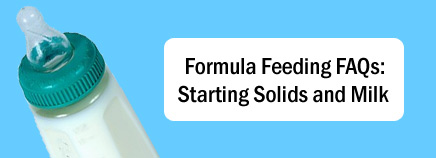
Whether you’ve decided to formula feed your baby from the start, are supplementing your breast milk with formula, or are switching from breast milk to formula, you’re bound to have questions. Here are answers to some common queries about formula feeding.
When should I introduce solid foods and juice?
The best time to introduce solid foods is when your baby has developed the skills needed to eat. This usually happens between the ages of 4 and 6 months. How do you know when your baby is ready?
Babies who are ready to eat solids foods:
- are interested in foods (for example, they may watch others eat, reach for food, and open their mouths when food approaches)
- hold up their heads well, and sit up with little or no help
- have the oral motor skills needed to eat (meaning that they don’t push food of the mouth but move it to the throat and swallow it)
- usually weigh twice their birth weight, or close to it
Wait until your baby is at least 4 months old and shows these signs of readiness before introducing solids. Babies who start solid foods before 4 months are at a higher risk of becoming obese.
When the time is right, start with a single-grain, iron-fortified cereal for babies (rice cereal has traditionally been the first food for babies, but you can start with any you prefer). Start with one or two tablespoons of cereal mixed with formula to achieve the right consistency. (As an alternative, you can give an iron-rich puréed meat.) Feed your baby with a small baby spoon, and never add cereal to a baby’s bottle unless your doctor instructs you to do so.
At this stage, solids should be fed after a bottle-feeding session, not before. That way, your baby fills up on formula, which should still be your baby’s main source of nutrients until age 1.
Once your baby gets the hang of eating cereal, introduce a variety of puréed fruits, vegetables, and meats. Wait a few days between introducing a new food to make sure your baby doesn’t have an allergic reaction.
Note: There is no benefit to offering fruit juice, even to older babies. Juice can fill them up and leave little room for more nutritious foods, promote obesity, cause diarrhea, and even put a baby at an increased risk for cavities when teeth start coming in.
When can I start giving my baby cow’s milk?
Before their first birthday, babies still need the nutrients in breast milk or formula. But at 1 year old, your baby can try whole cow’s milk. Why not skim or 2%? Because babies need the fat in whole milk for normal growth and brain development during the busy early toddler period.
You can transition your baby from formula to whole milk by beginning to replace bottles of formula with bottles — or sippy cups — of milk. By 1 year old, your baby should be eating a variety of other foods and only 2-3 cups (480-720 milliliters) of milk per day.
If your baby was put on a soy or hypoallergenic formula because of a milk allergy, talk to your doctor before introducing milk.
When can I start giving my baby water?
In their first few months, babies usually don’t need extra water. On very hot days, most babies do well with additional feedings. But you may want to offer your infant water, especially if your baby’s pee is dark or your baby urinates less frequently than usual.
Once your baby is eating solid foods, you can offer a few ounces of water between feedings, but don’t force it. Water that is fortified with fluoride will help your baby develop healthy teeth and gums. If you live in an area with nonfluoridated water, your doctor or dentist may prescribe fluoride drops.

